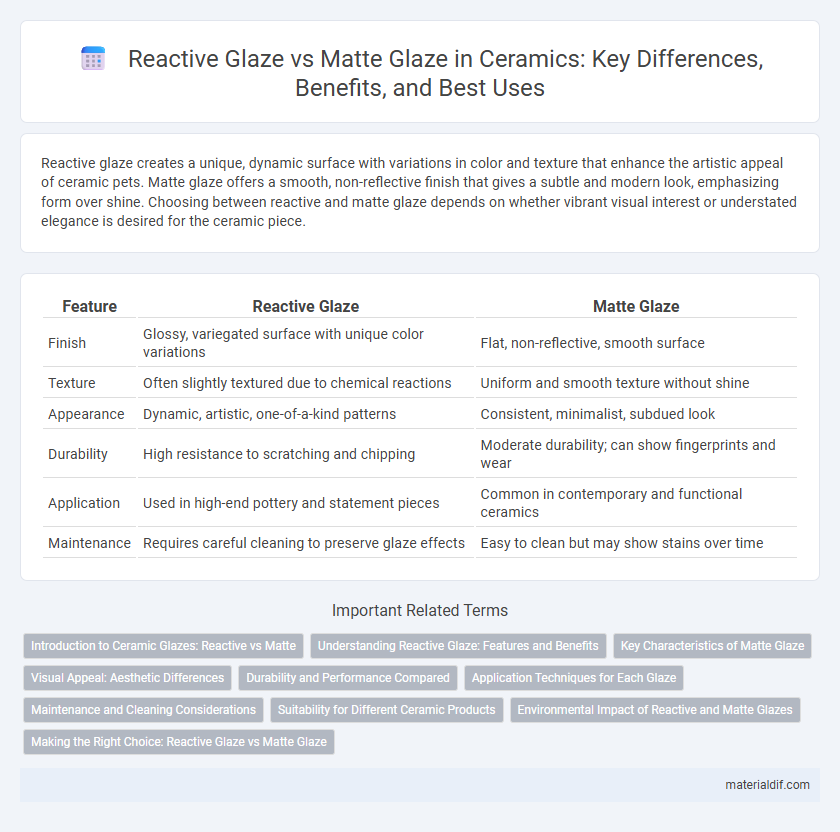Reactive glaze creates a unique, dynamic surface with variations in color and texture that enhance the artistic appeal of ceramic pets. Matte glaze offers a smooth, non-reflective finish that gives a subtle and modern look, emphasizing form over shine. Choosing between reactive and matte glaze depends on whether vibrant visual interest or understated elegance is desired for the ceramic piece.
Table of Comparison
| Feature | Reactive Glaze | Matte Glaze |
|---|---|---|
| Finish | Glossy, variegated surface with unique color variations | Flat, non-reflective, smooth surface |
| Texture | Often slightly textured due to chemical reactions | Uniform and smooth texture without shine |
| Appearance | Dynamic, artistic, one-of-a-kind patterns | Consistent, minimalist, subdued look |
| Durability | High resistance to scratching and chipping | Moderate durability; can show fingerprints and wear |
| Application | Used in high-end pottery and statement pieces | Common in contemporary and functional ceramics |
| Maintenance | Requires careful cleaning to preserve glaze effects | Easy to clean but may show stains over time |
Introduction to Ceramic Glazes: Reactive vs Matte
Ceramic glazes transform clay surfaces with distinct visual and textural effects, where reactive glazes create dynamic, variegated patterns through chemical reactions during firing. Matte glazes offer a smooth, non-reflective finish characterized by soft, muted colors and subtle textures, ideal for understated elegance. Understanding the differences between reactive and matte glazes enables ceramic artists to select finishes that enhance both function and aesthetic appeal.
Understanding Reactive Glaze: Features and Benefits
Reactive glaze in ceramics creates unique, variegated surface effects through complex chemical reactions during firing, resulting in rich textures and dynamic color variations. This glaze type enhances the visual depth and tactile quality of ceramic pieces, offering an artistic and organic finish that is highly sought after for its individuality. Compared to matte glaze, reactive glaze provides a glossy or semi-glossy sheen that highlights intricate details and vibrant hues, making each piece distinctly expressive.
Key Characteristics of Matte Glaze
Matte glaze features a non-reflective, velvety surface texture that enhances the tactile quality of ceramic pieces. It absorbs light rather than reflecting it, providing subdued, soft color tones ideal for minimalist or rustic designs. This glaze type is less prone to showing fingerprints and scratches, making it practical for everyday use in functional ceramics.
Visual Appeal: Aesthetic Differences
Reactive glaze creates a dynamic, variegated surface with rich depth and unpredictable color variations, enhancing visual interest and uniqueness in ceramic pieces. Matte glaze offers a smooth, non-reflective finish that emphasizes subtle texture and soft, muted tones, providing a minimalist and sophisticated aesthetic. The choice between reactive and matte glaze ultimately shapes the ceramic's visual appeal through contrasting finishes and color vibrancy.
Durability and Performance Compared
Reactive glaze offers enhanced durability due to its thicker, glass-like surface that resists scratches, stains, and wear better than matte glaze. Matte glaze, while providing a soft, non-reflective finish, tends to be more prone to chipping and surface damage over time. Performance-wise, reactive glaze is ideal for high-traffic or functional ceramic pieces requiring long-lasting protection, whereas matte glaze suits decorative items with less exposure to abrasion.
Application Techniques for Each Glaze
Reactive glaze requires careful layering and specific firing temperatures to achieve its characteristic variegated textures and depth, often applied by brushing or dipping to allow chemical reactions during firing. Matte glaze typically involves a smooth, even coat applied through spraying or dipping, with a focus on controlled cooling to maintain its soft, non-reflective surface. Understanding these distinct application techniques ensures optimal glaze performance and desired aesthetic effects on ceramic pieces.
Maintenance and Cleaning Considerations
Reactive glaze surfaces require gentle cleaning with non-abrasive materials to preserve their unique color variations and prevent surface damage, while matte glaze finishes resist fingerprints and smudges but are more prone to staining and require prompt cleaning. Both reactive and matte glazes benefit from regular sealing to enhance durability and minimize moisture absorption. Avoid harsh chemicals on reactive glazes to maintain their aesthetic, whereas mild detergents effectively keep matte glazes looking pristine.
Suitability for Different Ceramic Products
Reactive glaze creates unique, variegated finishes ideal for artistic pottery and decorative ceramics, enhancing texture and color depth. Matte glaze offers a smooth, non-reflective surface suitable for functional ware like dinner sets and tiles, providing a modern, understated aesthetic. Choosing between reactive and matte glazes depends on the intended use, durability requirements, and desired visual impact of the ceramic product.
Environmental Impact of Reactive and Matte Glazes
Reactive glazes often contain heavy metals and fluxes that can release harmful substances during firing, resulting in greater environmental pollution compared to matte glazes, which typically use simpler, less toxic formulations. Matte glazes generally require lower firing temperatures, reducing energy consumption and carbon emissions associated with ceramic production. Selecting matte glaze alternatives supports sustainable practices by minimizing hazardous waste and overall environmental footprint in the ceramics industry.
Making the Right Choice: Reactive Glaze vs Matte Glaze
Reactive glaze creates unique, variegated surfaces with unpredictable color blends, providing depth and texture ideal for artistic ceramics, while matte glaze offers a smooth, non-reflective finish that emphasizes form and subtlety. Choosing between reactive and matte glaze depends on the desired aesthetic effect, surface texture, and light interaction of the ceramic piece. For functional ware, matte glaze often ensures a consistent, muted look, whereas reactive glaze suits statement pieces requiring visual complexity.
Reactive Glaze vs Matte Glaze Infographic

 materialdif.com
materialdif.com